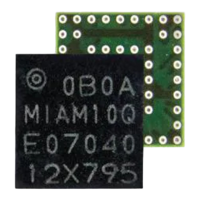MIA-M10Q-Integration manual
satellites, the services offered by the satellite, the configuration of the receiver (test mode allowed/
disallowed, integrity enabled/disabled) and the signal link quality to the satellite.
If corrections are available from the chosen SBAS satellite and used in the navigation calculation, the
differential status will be indicated in several output messages such as UBX-NAV-PVT, UBX-NAV-
STATUS, UBX-NAV-SAT, NMEA-GGA, NMEA-GLL, NMEA-RMC, and NMEA-GNS. The UBX-NAV-
SBAS message provides detailed information about which corrections are available and applied.
Refer to the interface description [3] for a detailed description of the messages.
The most important SBAS feature for accuracy improvement is ionosphere correction. The
measured data from regional Ranging and Integrity Monitoring Stations (RIMS) are combined to
make a Total Electron Content (TEC) map. This map is transferred to the receiver via SBAS satellites
to allow a correction of the ionosphere error on each received signal.
Message type Message content Source
0(0/2) Test mode All
1 PRN mask assignment Primary
2, 3, 4, 5 Fast corrections Primary
6 Integrity Primary
7 Fast correction degradation Primary
9 Satellite navigation (ephemeris) All
10 Degradation Primary
12 Time offset Primary
17 Satellite almanac All
18 Ionosphere grid point assignment Primary
24 Mixed fast / long-term corrections Primary
25 Long-term corrections Primary
26 Ionosphere delays Primary
Table 9: Supported SBAS messages
Each satellite serves a specific region and its correction signal is only useful within that region.
Planning is crucial to determine the best possible configuration, especially in areas where signals
from different SBAS systems can be received:
• Example 1 - SBAS receiver in North America: In eastern parts of North America, make sure
that EGNOS satellites do not take preference over WAAS satellites. The satellite signals from
the EGNOS system should be disallowed by using the PRN scan mask (configuration key CFG-
SBAS-PRNSCANMASK).
• Example 2 - SBAS receiver in Europe: Some WAAS satellite signals can be received in western
parts of Europe, therefore it is recommended that the satellites from all but the EGNOS system
should be disallowed using the PRN scan mask.
Although u-blox receivers try to select the best available SBAS correction data, it is
recommended to configure them to exclude unwanted SBAS satellites.
To configure the SBAS functionality, use the CFG-SBAS-* configuration group.
Parameter Description
CFG-SIGNAL-SBAS_ENA Enabled/disabled status of the SBAS subsystem
CFG-SBAS-USE_TESTMODE Allow/disallow SBAS usage from satellites in test mode
CFG-SBAS-USE_RANGING Use the SBAS satellites for navigation (ranging)
CFG-SBAS-USE_DIFFCORR Combined enable/disable switch for fast, long-term, and ionosphere corrections
UBX-21028173 - R01
2 Receiver functionality Page 19 of 89
C1-Public

